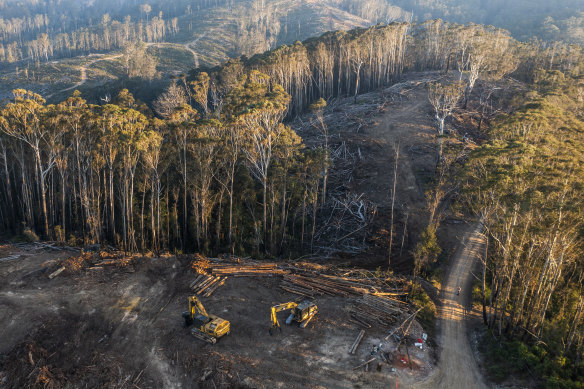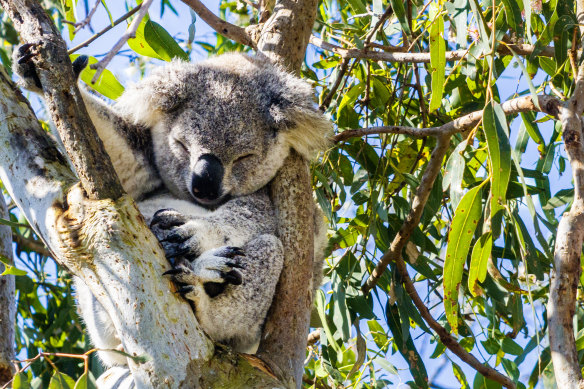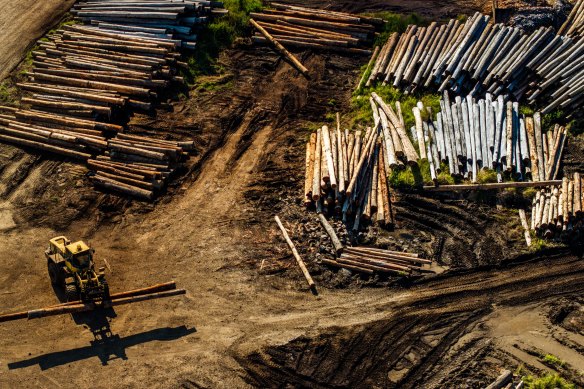
Greens parliamentarian Sue Higginson said there was mounting frustration among members of the progressive crossbench as well.
Jump in logging intensity
The Great Koala National Park will add state forests to the existing national park estate on the Mid North Coast, providing better connectivity of habitat for wildlife, especially koalas, as climate change progresses.
The assessment area includes 176,000 hectares of state forest. It’s widely expected that a committee led by National Parks and Wildlife Service head Atticus Fleming will make its recommendation by Christmas.
A report from Wilderness Australia and the National Parks Association NSW draws data from NSW Forestry Corporation’s own portal. As of October 7 this year, there were 13 active logging operations totalling a minimum of 7256 hectares inside the 176,000 hectares of state forest inside the park’s assessment area. This compares with 12 active logging operations totalling 7066 hectares inside the remaining 742,000 hectares of state forest in northern NSW.
This means that more than 4 per cent of state forests inside the proposed park is being logged, compared with less than 1 per cent in the surrounding area.
Concerns over the intensity of tree felling in the region prompted the government to end logging in 106 designated “koala hubs” covering 8000 hectares in September 2023 while the park boundaries were finalised. The report says 30 per cent of the hubs had already been logged by this point.
Sharpe declined to answer questions, but a spokesperson for the Department of Climate Change, Energy, the Environment and Water said the government would deliver its commitment to create the park. Labor first took the policy to create the national park to the 2015 election.
The department said there was less logging by volume in the park’s assessment area in the past 10 years than in the previous decade, consistent with a broader industry decline.
However, the department acknowledged that the proportion of timber from the north-east region that came from the Great Koala National Park assessment area had increased from 20.1 per cent in the 2003-14 period to 22.8 per cent since 2015.

Logging in Wild Cattle Creek near Coffs Harbour in 2022.Credit: Paul Hilton / Earth Tree Images
The jump is even higher by area. Dalian Pugh, co-founder of the North East Forest Alliance, said the assessment area covered just 16 per cent of the state forests in northern NSW. From 2003-04 to 2014-15, the logging of native forests inside that zone averaged 28.7 per cent of the logging in the region.
In 2015-16, after Labor announced its policy, it jumped to 42.3 per cent. Since then, it has averaged 37 per cent.
James Jooste, NSW chief executive for the industry lobby group Australian Forest Products Association, said there was more logging within the assessment area because it contained the most productive forests.
“They drew the map [for the proposed park] on purpose because they’re not looking for an environmental outcome; they’re looking for a political outcome, and that’s the end of a native forestry industry,” Jooste said.
‘I think you’re talking about an industry which is equivalent to whaling.’
Former NSW environment minister Bob Debus
A Forestry Corp spokesperson said in a statement that all its operations used selective logging and the highest levels of koala tree protection.
“The state forests on the North Coast have been continuously harvested and regrown for more than 100 years and have maintained their ecological and habitat value, with surveys continually showing strong koala occupancy across harvested and unharvested areas,” the spokesperson said.
Wilderness Australia director Virginia Young said selective logging was a furphy because the biggest, most valuable trees were also best for koalas, while the disturbance and increased sunlight-enabled weeds such as lantana.
Loading
“The actual area that has been logged is available from satellite data, so you can see it, and it fragments the forest,” Young said. She also pointed out Forestry Corp’s repeated breaches of the law.
‘A criminal organisation’
The NSW Environment Protection Authority has 22 open investigations against Forestry Corp. A case where Forestry Corp pleaded guilty to illegally felling giant and hollow-bearing trees at Wild Cattle Creek near Coffs Harbour is awaiting sentencing in the Land and Environment Court.
In August, the same court slapped a $360,000 fine on Forestry Corp for environmental crimes elsewhere in NSW. Justice Rachel Pepper found Forestry Corp had “a significant history of unlawfully carrying out forestry operations”, and the fines “must serve to deter it from future criminality”.
In January this year, two Forestry Corp contractors were found guilty of assaulting two forest activists near Dorrigo. No conviction was recorded.

The Great Koala National Park is intended to provide habitat for the iconic species.Credit: Paul Hilton / Earth Tree Images
Millionaire businessman turned forest campaigner Geoff Cousins said Forestry Corp was a “criminal organisation”, as was its union, the CFMEU.
Cousins said Forestry Corp’s pattern of behaviour suggested the NSW government, the sole owner, had lost control.
“As I know well from my corporate life, a 100 per cent-owned subsidiary is the corporation itself,” Cousins said. “That is the NSW government who has been convicted of those offences, in essence.”
Loading
Cousins has met Sharpe, Agriculture Minister Tara Moriarty and Treasurer Daniel Mookhey separately this year. He found the treasurer was “uninformed” about the criminality and “surprised” at the suggestion that it was his responsibility as the senior government shareholder. Mookhey declined to comment.
The Forestry Corp spokesperson said it had increased its spending on compliance and “regrets any past instances where it did not meet all the conditions of [its logging] approval”.
‘A very profitable exercise’
In late October, the Australian government agreed to develop a proposal from the NSW government to add forest preservation to the Australian Carbon Credit Unit Scheme. If adopted, it would provide an incentive for state governments to cease or defer logging.
Former Australian Treasury secretary Ken Henry, also chairman of the Australian Climate and Biodiversity Foundation, said the credits could fund forest maintenance and benefit communities.
“The native forest division of [Forestry Corp] is hardly a money spinner for the taxpayer of NSW,” Henry said. “This turns it around completely. It has the potential to be a very profitable exercise for the taxpayers in NSW who, of course, are the ones who own these native forests.”

A mill near Dorrigo in July 2024.Credit: Paul Hilton / Earth Tree Images
Cousins said the NSW government told him the national park could be bigger if people like him endorsed the carbon credits scheme, but he would not invest the time until the government first ended logging in areas it knew would definitely or probably be part of the park.
Forestry Corp’s hardwood division is loss making. The spokesperson said native forestry was not subsidised by taxpayers; instead, timber revenue subsidised land management services that were only partly government-funded.
Loading
Jooste shared EY research suggesting the NSW hardwood industry directly delivered $2.75 billion in gross revenue, including value-added services such as sawmilling, and 5920 jobs. He argued that imported timber would have worse environmental outcomes.
However, Debus described the product as “generally speaking, very low grade these days” and claimed the industry “cannot exist without a subsidy from taxpayers”.
Debus said ending native forest logging was more pressing now than when he was in government because climate change was intensifying and causing mega bushfires.
“I think you’re talking about an industry which is equivalent to whaling,” Debus said. “I think the industry itself is heading towards extinction. The only question is, how much environmental damage it does on the way out.”



























